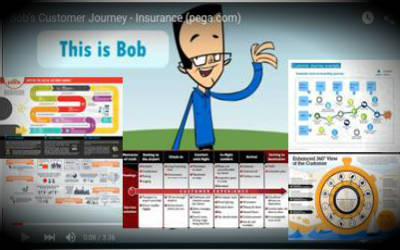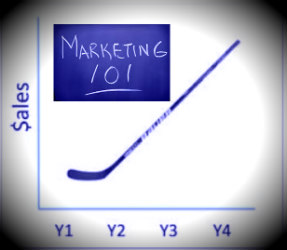
by Rita Baker | Oct 21, 2015 | Marketing
It used to be that one could decide, almost on a whim, to put a business on the web and expect some results with minimal online marketing efforts. If you have tried this recently, you know it is definitely not the case today.
Despite not having a reliable worldwide statistics on how many online businesses are started each year, we can extrapolate (mostly from US data) that the number of new online businesses worldwide is in the tens of millions yearly. Almost as many fail, but the web is still left with a fast growing number of businesses.
So what can you do, as an online retailer, to find, keep and delight customers?
The web is crowded today. It will be exponentially more crowded in the future as putting a business online gets easier.
Try to imagine a shopping mall with hundreds of thousands of easily reachable businesses who want to sell to you. The mall is so packed that you can’t really see any of the stores unless you are in front of them. The inventory they hold is mind boginly huge.
Now that the image has sunk in, ask yourself if these businesses were to use the online marketing techniques currently used by ebusinesses, would you want to buy from them?
Using this same analogy, would you buy from any of these businesses in that mall if:
- While you are walking around, you spot an interesting information billboard and stop to read it. As you start reading, a bunch of retailers come out of their store and start talking to you, some even standing between you and the billboard, about their products that you have no interest in.
⇒ Online, mobile an pop-up ads
- While you walk around the mall hundreds of retailers you have never heard of chase you and stuff little messages in your pockets.
⇒ spam, unwanted emails
- While you were in the mall, a store caught your attention and you went inside to look at a display that turned out to be uninteresting. Ever since that moment, the retailer pops up everywhere you look and keeps showing you the products on the display you looked at.
⇒ uninformed re-targeting
The answer to whether you would want to buy from any of them is, for the vast majority, a resounding no.
Yet, this is how most online marketing is currently done.
So now, let’s try to figure out what it would take for you to not only notice one of these businesses in the mall of over plenty but want to buy from this retailer repeatedly.
The web marketing/advertising community is starting to take steps in one of the right directions. The other directions we have yet to figure out.
A growing number of recent online promotional and advertising techniques are yielding good results. These techniques share two commonalities:
- They answer a real need in the correct way
- They contribute to building a relationship with the customer
Answering a need
A need can be latent or expressed. It can be that of a customer segment (defined as sharing a same need) or of a single customer. The underlying implication is that the need, and its context, are known. This in turn implies that effort has been put into thoroughly understanding customers’ needs, and their context, as well as being able to adapt to the various ones in the segments you target.
Building a relationship
 A relationship is the away a person communicates, behaves and deals with someone else based, in large part, on the level of trust between them.
A relationship is the away a person communicates, behaves and deals with someone else based, in large part, on the level of trust between them.
It used to be that customers bought from their local merchants. The merchants spent time talking and getting to know their customers and their families and vice versa. Customers would see their merchant at the village church or in other social settings. They knew where and how the merchant lived. All this information increased trust and facilitated the building of a relationship between customers and the merchant.
The villages eventually grew into large cities. Merchants became strangers who sold brand name products created by faceless corporations. The only information available to customers to build a relationship pertained to the brand and it was controlled. As we all know, the brand information we receive is rarely sufficient to get the entire or even the real picture.
The advent of social media is now allowing a glimpse, and what may soon become a full view, into not only the brand and the corporation but also how the owners and employees manage it. This last information is much more relevant to consumers to build relationships than information on brand or company is.
We are now back to our mall of plenty analogy. Let’s say you are there shopping for some gluten free chocolate to give to your spouse for Halloween.
- As you are walking around you spot an interactive billboard on gluten free treats for Halloween and you stop to read. As you select to get more information on chocolates, a few merchants come out of their shops to talk with you. They pleasantly ask you questions on your purchase intentions, on your spouse’s preferences and your own. The merchants who know they have products that answer the needs they just discovered ask if you would like more information on their chocolate selection. They thank you and wish you a good day.
⇒ Bi-directional, targeted promotional information
- As you continue walking about the mall, two of the retailers, who you accepted to get information from, come to offer you gluten free chocolate samples and give you information on their selection and prices. They also engage you in a short conversation with the goal of getting to know you better. One of the retailers quickly picks up that you are a sniper shopper (target what you want beforehand, go for it and leave the shop quickly). She offers to present you only the chocolates that fit your spouse’s taste and have access to an express checkout line.
⇒ Targeted email and tailored shopping experience
- You end up purchasing from this retailer. Over the next few months, the retailer you purchased from sends you occasional and useful information, discounts on gluten-free food items and offers you a free membership to a local information sharing community of people living with someone on a gluten free diet they manage. Fast forward to February, you are back at the mall of plenty to get your spouse a box of Valentine chocolates. As you walk in, your Halloween chocolate merchant comes to greet you with a smile and a discount offer on a beautifully wrapped box of gluten free chocolates you know your spouse will like.
⇒ Targeted offer based on accurate need information
Seriously, if this was the scenario, would you spend any energy shopping around given you are a sniper shopper?
The approaches used by the retailers in the above scenarios are all based on understanding the needs of their customer and building a relationship with him/her.
Ask yourself if your current promotional and advertising efforts on the web are based on answering your customers’ needs and contributing to building a relationship with them. If not, you may soon be replaced by a competitor who will.

by Rita Baker | Oct 14, 2015 | Marketing
When is the last time you took a good look at what your customers’ entire experience is like when they deal with your company? If your answer is: Never or not in the last couple of years, you may want to read on.
What is a customer experience journey?
A customer experience journey (aka customer experience map) is the detailed (or sometimes not so detailed) analysis of the experience a specific customer segment has when interacting with your organisation for its entire life cycle, either through one of your employees or any media content you issue. If you really want to dig down, mapping your customers’ interactions with third parties representing your brand (suppliers, distributors, etc.) can also be examined. This information is then presented either graphically or via tables. If a customer experience journey needs to be communicated quickly to a large group of people, a video is sometimes produced to get the information across.
How a customer experience journey is done
 The customers’ experience is mapped from the top of the sales funnel all the way down to the last segment of the retention and propagation pyramid. Additionally, specific actions such as purchase, usage and customer loss will be broken down to reflect any potential customer touch points.
The customers’ experience is mapped from the top of the sales funnel all the way down to the last segment of the retention and propagation pyramid. Additionally, specific actions such as purchase, usage and customer loss will be broken down to reflect any potential customer touch points.
Organisations usually task marketing management to accomplish the mapping. Idealy, it should however be done by a team of the top managers of every department that has customer touch points.
If this is your first time at doing a customer experience journey, you can start with the areas where you think there are issues. These will generally yield the highest returns for your organisation. Once you get the hang of it, you can add customer touch points to your journey progressively until you cover the entire spectrum of your customers’ experience with your organisation.
Benefits of mapping the customer experience journey
Returns! Yes, I did write returns. If you have read this blog for a while, you know I would not recommend any costly marketing action unless it has the potential to be profitable for your organisation. Your first endeavors into mapping your customers journey will generally yield the highest results. Those results can have a dramatic effect on your bottom line.
Managers and owners are usually aware of certain ‘’glitches’’ in the experience they offer their customers. Seldom are they prepared for the results a first mapping produces. Their initial reaction is often one of shame and/or impressions that their organisation is bleeding money unnecessarily. Their second reaction is to start acting to resolve the issues brought to light by the mapping exercise.
Typically, a customer journey mapping exercise and the implementation of action plans to correct issues identified yield:
- Reduced rate of customer churn
- Reduced customer service costs
- Increased customer lifetime value
- Better propagation (referral and advocacy), leading to
- Better reputation
- A marked increase in internal innovations of all types (usually non disruptive)
Each of these benefits brings sub-benefits which also yield financial returns.
A large proportion of these returns usually go straight to the bottom line. It makes sense given that improving your customers’ experience is equivalent to making your organisation more efficient at fulfilling its mission, which boils down to satisfying your customers’ needs.
If you are looking for lasting ways to increase your profits at a higher rate than your costs, mapping your customers’ journey through your organisation may be your answer.

by Rita Baker | Sep 30, 2015 | Marketing
Are you familiar with the sales funnel? I am guessing you are.
Are you familiar with digital advertising? I am guessing you have at least heard about it and many of you have probably already ran Adword campaigns.
What I realised a few weeks ago, when I was giving a presentation on digital marketing to a room full of entrepreneurs, is that very few used the sales funnel in conjunction with digital advertising.
Using the sales funnel with any advertising action will allow you to not only better design your campaign but also calculate the anticipated return from your advertising expense.
Digital advertising (excluding mobile) can come in the form of search engine advertising (e.g. Adword), social media (e.g. Facebook) or general web advertising. It can be done on a web page, within a video or a document (like a white paper).
The type of product/service, market conditions, the type of advertisement and its content will determine on what part of the funnel it is most effective.
Once you have determined on what part of the funnel you want to act on and the conversion rate you are seeking, you can chose the type of advertisement, the medium (web page or video), the ad content and format and the budget that will be best suited to reach your goals. You can also take it the other way around and start with the budget you have and determine your course of action from there.
Your typical conversion rates from one section of the funnel to the next, the lifetime value of your customers[1], along with a starting point estimate of the number of potential customers coming into your funnel, will help you determine the approximate returns you can anticipate from your digital campaign.
Here is an example to help you understand how you could apply this method on your next digital advertising campaign. Please keep in mind that the numbers used in the following example are not representative of anything. The truth is that the average conversion numbers you may see on the web have absolutely no statistical significance. Dozens of factors affect conversion rates. The only numbers you should rely on to see if you’re doing well or not are your own historical metrics.
We’ll start by going through the stages of the sales funnel. First your potential customers must know that your online store exists. Then they need to understand what you have to offer. Those who are interested by your offer will consider whether or not they want to purchase. The ones who have decided to purchase your product/service have to act on their decision and purchase.
Let’s sa y you are at a point where you wish to focus your marketing campaign at convincing customers your product best suits their needs and having them buy from you (usually why one does an advertising campaign).
y you are at a point where you wish to focus your marketing campaign at convincing customers your product best suits their needs and having them buy from you (usually why one does an advertising campaign).
- Your net analytics historical data (I am referring to data that has been scrubbed of all the false traffic which may account for up to 85% of your raw traffic numbers) has allowed you to track as a cohort[2], 1000 unique visitors.
- Out of those, 650 did not bounce.
- From those 650, 300 have acted in a way that shows interest (signed up to a newsletter or promotion, downloaded a document, etc.).
- Out of these 300, 60 are considering your product (they have gone to a product page, have asked questions via your IM function, etc.).
- Out of those, 40 have shown intent to purchase (opened an account, started a shopping cart, downloaded a coupon code, etc.).
- Finally, half of those who intended to buy from your site made a purchase. These metrics give you your conversion rates from one stage of the funnel to the next.
To get to your conversion rate you simply divide the bottom stage data with the data from the stage right above it and multiply it by 100.
Now that you know what stage of the funnel you are targeting (intent and purchase), and you have your conversion rates and lifetime customer value, you are all set to pick the best advertising tool and estimate your returns.
You analytics data can show you characteristics of past visitors who converted on the consideration, intent and purchase stages. Using this data, you can target potential customers with similar characteristics. The characteristics will give you clues as to what advertising platform will be the most effective. Are your visitors in the consideration, intent and purchase stages, mostly women aged 17-25, who have interest in family and food? You may want to take a look at advertising on Pinterest or Facebook. Adwords can also target such an audience if you don’t think social media platforms are right.
Adwords can give you an estimate of how many clicks you can expect with a fixed budget and the profile (keywords) selected. Use this data, along with your conversion rate and your customer lifetime value to estimate the revenues you can expect from your campaign. Chose the platform that will give you the best returns on your advertising expense. The figure below shows the calculations for this example.
 In this example, any marketing campaign that costs you less than 5 000$ (you may want to give yourself a positive margin of error to ensure you don’t have negative returns) will add value to your company.
In this example, any marketing campaign that costs you less than 5 000$ (you may want to give yourself a positive margin of error to ensure you don’t have negative returns) will add value to your company.
Finally, when you are starting your company, these calculations are far from exact. Only experience will increase your precision. The sooner you start calculating your marketing action ROI the sooner you will get good at it. You will get an understanding of the data that will incite you to start improving your CLV and conversion rates.
Have you started using the sales funnel to improve your web advertising efficiency yet? What are you waiting for?
[1] The simplest formula to calculate Life-time customer value (LCV) is LCV = total gross sales revenue of period X/number of unique customers during period X. There a many other formulas to refine this metric.
[2] A cohort is simply a group of visitors that you tag in your analytics software as a group so that you can apply data to the entire group. There are multiple variables by which you can identify a cohort. One of the most popular is the period during which they visited your website.

by Rita Baker | Aug 26, 2015 | Marketing
Let’s face it. The vast majority of entrepreneurs don’t think they’ll need to do any marketing efforts, so my question may not be relevant to them. A few of them may be right, but only a very few. Those who were brilliant enough to create a disruptive product or service that is a perfect fit with the needs of a large enough market don’t need to put much effort into their marketing initially. The rest of us do. Hence if you’re in the second or third year of your start-up and your hockey stick[1] still doesn’t have much of a handle, it’s a clear indicator that you needed to deploy marketing efforts and need the answer to the title question.
Do I need to do marketing for my start-up?
It would have been nice had someone told me how to know that I needed marketing at the very beginning of my venture you say? So here are a few indicators that show you will need to deploy, at least some marketing efforts, from the get go.
- You have more than a couple of competitors or substitutes in your market
- Your product or service is aimed at other businesses (businesses are not very good at finding even the perfect fit solutions)
- Your product or service is not self explanatory
- Your product or service is luxury priced or high cost
- You are targeting a market where information is not free flowing
There are many other situations but those are the most common ones.
So now that you know you need to do marketing for your start-up, how do you go about defining the pillars of your marketing; your customer segments?
What is a customer segment?
 If you are new to the practice of marketing and you take a look at the definition of a customer segment, it won’t be terribly useful to you at best and may even lead you astray.
If you are new to the practice of marketing and you take a look at the definition of a customer segment, it won’t be terribly useful to you at best and may even lead you astray.
Defining your market segments solely as a group of customers with homogenous characteristics (whichever one you may think of) is not going to help you much in reaching your goals.
You need a purpose
In order for a customer segment to be of use it must be actionable and enable you to achieve whatever marketing, product or business goals you are going after. This entails of course that you are thinking a few steps ahead and define the goals (business, product or marketing) you want to reach in the near future and tactics you are likely to use to reach them.
Making it real
Let’s say your product is a mobile phone controlled smart night light, and you need to figure out what features to put in your mobile app. which controls the light, to maximise your sales. If you treat your early adopters as a segment it will not be very useful unless it so happens that they all have the exact same needs regarding the application. This is highly unlikely as your smart night light may attract initial interest from students, young professionals, parents and other types of customers who happen to be tech savvy. Although they are all your early adopters, their needs regarding the application features and marketing approach will differ greatly.
On the other hand, if your goal is to test a product feature that will not change across market segments, such as an on/off switch on the light, then using your early adopters as a market segment makes complete sense.
Lesson learned
Can your early adopters be treated as a customer segment? The answer is, only if by doing so you can answer the questions that you need addressing at a specific time and place. Most of the time, you will need to refine your segmentation before it is useful to you.
[1] Shape of the revenue curve of highly successful start-ups

by Rita Baker | Jul 20, 2015 | Marketing
L’argument pour la rentabilité d’un bon contenu web n’est plus à faire. Qu’il s’agisse de:
- Faire connaître votre marque
- Renforcer (voir mieux contrôler) son image corporative
- Attirer des clients potentiels/Accroître ses revenus
- Fidéliser les clients existants
- Améliorer l’expérience clients
- Améliorer son service à la clientèle et/ou minimiser son coût
- Mieux connaître sa clientèle
- Attirer les meilleurs employés
- Se faire remarquer des investisseurs potentiels
- Accumuler du capital social
Votre contenu web contribuera significativement à l’atteinte de tous ces objectifs et d’autres, dans la mesure où il est bien géré.
Comme pour toute autre activité dans votre entreprise, plus les efforts déployés pour votre contenu web seront efficients plus votre retour sera important. Malheureusement, une majorité d’entreprises se limitent à la production de contenu sans trop se soucier de sa planification, ou d’en contrôler les résultats. Les cinq étapes qui suivent comptent parmi les bonnes pratiques à mettre en place dans votre organisation afin de s’assurer de maximiser les retours sur les efforts déployés pour votre contenu web.
1 – Développer une stratégie de contenu
J’ai déjà élaboré sur la stratégie de contenu web dans un précédent billet alors je ne m’y attarderai pas trop. Il suffit ici de noter que si le contenu web n’est pas lié à la stratégie générale de l’entreprise et que les diverses tactiques ne sont pas coordonnées entre elles les résultats ne seront pas au rendez-vous. Le risque d’engendrer des coûts inutiles est également très élevé sans planification.
2 – Définir des objectifs de communication clairs
Pour chaque type de contenu web un, ou quelques, objectifs de communication doivent être définis. Non seulement vos objectifs vous aideront-ils à écrire un meilleur contenu mais ils sont également nécessaires afin de mesurer les résultats obtenus.
3 – Produire un contenu adapté et de qualité
Un contenu produit sur le web est littéralement une goutte dans un océan. Afin de se démarquer il est utile de traiter chaque pièce de contenu web comme un nouveau produit. On doit d’abord s’assurer que le contenu répond aux besoins/désirs de notre clientèle-cible. Cet énoncé suppose que l’on a déjà identifié notre clientèle-cible et ensuite qu’on a fait les efforts nécessaires pour connaître ses besoins en matière de contenu web, cela en fonction de nos objectifs. Cette maîtrise des besoins votre clientèle-cible influencera votre style rédactionnel, les mots utilisés, la mise en page de même que le choix du canal de communication numérique. Plus votre contenu web répondra étroitement aux besoins de vos lecteurs-cible, plus votre auditoire sera important et plus la probabilité d’atteindre vos objectifs sera grande.
On doit également produire un contenu de qualité. Ce qui implique un orthographe et une grammaire impeccables, de même qu’une structure de texte facilement compréhensible par vos lecteurs.
4 – Promouvoir son contenu

Dans le cas où la concurrence pour l’attention de votre clientèle-cible est forte sur le web, produire un contenu adapté et de qualité n’est parfois pas suffisant. Si votre auditoire n’est pas à la hauteur de vos efforts il faudra alors prévoir un plan de promotion pour votre contenu web.
Une majorité de vos activités de promotion s’effectuera sur le web même, à partir de vos autres contenus, mais il ne faut pas négliger les tactiques de promotions classiques telles les médias écrits (revues, cartes d’affaires, etc.) ou visuels (ex. pub télé, panneaux d’affichage).
5 – Mesurer les résultats obtenus
Enfin, et il s’agit ici du parent pauvre de la production de contenu web, mesurer les résultats obtenus par nos différentes pièces de contenu est essentiel. La mesure de vos résultats permettra non seulement de connaître la rentabilité de votre contenu, mais également de déceler les types de contenus les plus performantes pour notre organisation.
Le web analytique devient de plus en plus accessible aux organisations de toute taille (voir ce billet de Techo Marketing). Même sans être un as de l’analytique, des connaissances de base sont souvent suffisantes afin de nous donner une idée de l’efficacité de nos divers contenus web.
La majorité de ces étapes font appel à des disciplines où l’apprentissage peut prendre des années. Il ne faut pas se décourager pour autant. Déjà, en respectant chacune de ces étapes, et en faisant de son mieux avec des connaissances de base permettra d’améliorer la rentabilité de votre contenu.

by Rita Baker | Jun 9, 2015 | Marketing
Not so long ago, mastering the marketing-mix 4 Ps (then came the 7Ps), made you a decent marketer. If you also knew how to create content for the company website and manage the Facebook account, you were tops. Showing only these skills on your resume today will most likely not get you into the door of most employers.
How is it different today?
Because of the enormous impact everything internet related has had on both companies (supply side) and market behaviours (demand side) in the last decades, the optimal marketing skill sets have drastically changed for everyone including marketers. In all sectors of the economy (the primary sector being less impacted at this time), most products or services have an internet related components in their marketing mix. In the manufacturing sector, we can think of customer community assisted product design and online private markets. In retailing, e-commerce and digital marketing are omnipresent.
Today’s basic marketing skills are significantly wider-based than previously. The brain having a limit as to how much it can master, this creates more of a divide along the lines of generalists and specialists in the marketing function than ever before
In larger companies, a proliferation of new marketing functions has been observed in the last few years. Some of these functions are cross-over functions with the IT department. IT trained employees with secondary training in marketing can be as useful as marketing graduates with IT training.
Completely new marketing functions requiring statistical training and/or information systems training are also starting to appear.
What does it mean for the marketing management required skill set?
In large corporations, new marketing divisions are being created. In this context marketing management skills can be closely matched with those of the functional resources.
In mid size companies with limited resources this usually means that marketing management will need to supervise resources with a wide variety of skill sets. Marketing VPs and Directors will in turn need to train to acquire basic knowledge in the spheres where they are deficient. Managing a team without, at the very least, basic knowledge in all pertinent marketing areas will be inefficient at best and disastrous at worst.
I have also witnessed a reality; don’t have sufficient data to call it a trend, in companies of various sizes where IT engineers and information system specialists with very limited training and experience in marketing are hired to manage teams or perform high level marketing functions. This is just as bad an idea as hiring a marketer who read a few engineering books and took an engineering class or two to build a bridge. Marketing managers, now more than ever, require a deep understanding of the marketing function to ensure maximum returns on every marketing dollar invested.

How this translates to small businesses and start-ups
What is a small business or start-up owner to do in the face of such a broad spectrum of required skills to tend to the marketing function? First, accept that you will not have the resources to cover all your bases in-house. Second, get yourself the most business minded, highly marketing trained, experienced person who learns quickly and is willing to learn continuously, that you can afford, even if you can only afford them part-time. This gem will not only be able to find the right external resources to complete your marketing needs but, more importantly, will be able to create a marketing strategy that will identify the marketing tactics for your company which bring the highest ROI.
When looking at it from an investment perspective, the math becomes simple. Would you rather spend X on a lower-skilled marketing resource and receive a fraction of X in return or invest 2X on highly skilled marketing resources (internal and external) and get multiple of X in return?

 A relationship is the away a person communicates, behaves and deals with someone else based, in large part, on the level of trust between them.
A relationship is the away a person communicates, behaves and deals with someone else based, in large part, on the level of trust between them.










